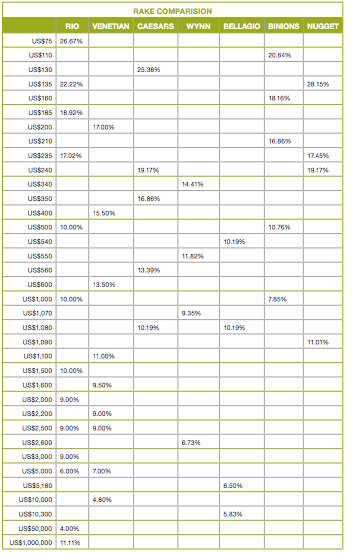Juicy Game?
Tuesday, 31 July 2012
Live tournament poker constantly evolves and Vegas during the World Series is a good place to assess the current mood. Whatever trend catches on there usually echoes across the poker world. If that’s so, then this summer’s vogue won’t be so popular with players. After the evolution to deep structured tournaments, it seems a few major casinos are beginning to count the costs.
It’s long been said that card rooms don’t make much money on poker tournaments – that they run them to get the punters through the door in the hope that they’ll play the cash tables and pit games. Certainly, the recent migration to ever more generous structures requires more dealers and tournament staff for longer periods of time, and only the truly thronging card rooms (eg DTD over here and the Rio or Venetian in Vegas) can profit big from such tournaments alone.
It seems that for a while there’s been a “magic 10%” barrier on tournament juice. Certainly, breaching this barrier hasn’t been a taboo in Vegas – definitely not for the small buy in tournaments around the $100 or $200 mark – but this year has seen these card rooms be more brazen for higher buy ins.
The Venetian, for example, moved to expressing their buy ins as a final figure, from which the juice gets subtracted as a percentage (something the WSOP has done for years). In general, this can add a percent or so to the bottom line as not many punters realise the following difference:
$900 + $100 = $1000; the juice is $100/$1000, or 10%
$1000 + $100 = $1100; the juice is $100/$1100, or 9.1%
Not only that, but many casinos just upped the percentage juice figure this year for the $300-$600 buy in tournaments to around 13% to 15%, with only the $1000-$1500 buy in tournaments remaining around the 10% mark. The following table provides a valuable comparison:

As you can see, the juice on the low buy in events (around the $100 to $200 mark) is pretty steep – up to 19% in the case of Caesars. Granted, you’re pretty unlikely to find yourself on a tough table in one of these tournaments (Sam Razavi refers to them as “clownfests”), but still, 19% is a whole lot of juice to overcome.
The mid-range ($300 to $600) tournaments are the ones which have changed the most. Last year, the juice for this range of buy-in was around 11% to 12% or so, once you had included staff costs and percentages for leaderboards (and yes, this being Vegas, they still have the gall to ask if you’ll tip them when you cash). This year that figure seems to have crept up to around 15%.
Don’t get me wrong; these tournaments are definitely fishy. I think that even with such high juice, the punter is still getting value. It’s just that a comparison is warranted because the structures of each festival are largely the same, yet the juice is much smaller in certain card rooms.
The winner on that count this summer as far as I was concerned was the Wynn. Many punters shy away from the tournaments at the Wynn because they only get around 70 to 100 runners a day for their $340 or $550 dailies. The logic – however flawed it may be – that you can get a bigger prize in a bigger field (yes, but you will hit it less often) seems irresistible. Hence, people flock to the big events of the Venetian (around 300 to 700 runners each day) or Caesars (200 to 400 runners) and pay almost 2% more juice.
The big daddy of them all is the Rio, which gets thousands of runners for its $1,000 and $1,500 NLHE bracelet events, despite their lack of deep structures. In their defence, the juice has remained relatively low over the years, at around 9% or 10%. This year, their daily $235 deepstack was perhaps the most popular side event in Vegas, getting well over 1,000 runners a day, despite having 17% juice and a terrible structure!
The Wynn was evidently trying hard to bring the punters in, as the juice on the mid-range buy-ins remained lower than Caesars and the Venetian. I also found the structure there to be slightly better, with the odd extra level mid-tournament. Caesars offered no comps this year. The Venetian stuck to its one $10 comp per buy in (either for food or DSE merchandise). The Wynn was relatively innovative with a standard $10 food comp, plus a $10 bonus comp for registering before the tournament begins (nota bene, Grosvenor Casinos: the carrot and not the stick), plus a final $10 bonus comp if you could prove that you had played a tournament elsewhere the day before!
The Venetian has also improved its Deepstack Extravaganza by moving it to the Palazzo gaming floor. There is considerably more room and less intrusion from the surrounding slot machines. Unfortunately, if you last until the evening, the ambient noise is still far too loud. I interviewed Venetian poker’s Kathy Raymond last year about the DSE, and she hinted that she would like, one day, to be in a dedicated room or conference centre a la Rio. The Wynn and Caesars both have dedicated card rooms well away from the “bing! bing!” and I have to say they are much less stressful to play poker in.
Will UK card rooms pick up on the move to higher percentages of rake in Vegas? I wouldn’t be surprised. For a couple of years now, tournament directors have been scratching their heads, trying to work out which level to skip, how long they can make the punters play each day, or fudging the stack size so that it looks big but in fact you start at a later blind level. They may see increased juice as a solution to their problems. Whether the punters see it that way is another question.